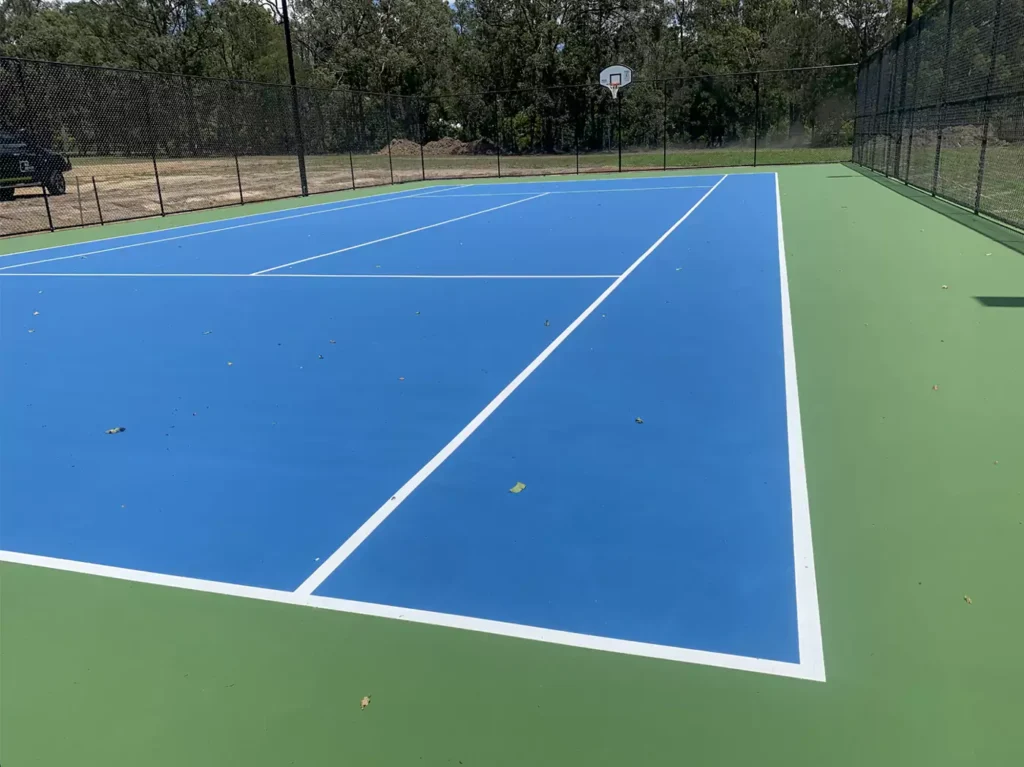Pickleball court construction is a process that requires meticulous planning and execution. As the sport continues to grow in popularity, the demand for high-quality pickleball courts has never been higher. This article outlines the essential steps involved in constructing a pickleball court, offering best practices and highlighting common pitfalls to avoid.
Understanding the Basics
Embarking on a pickleball court construction project starts with a solid grasp of the essential dimensions and specifications that define a regulation pickleball court. A standard court is delineated by a playing area of 20 feet in width and 44 feet in length. Within this space, the net plays a pivotal role, stretching across the width of the court with a height of 36 inches at the sidelines and dipping slightly to 34 inches at the center. Additionally, the service areas and non-volley zone, or ‘kitchen,’ must adhere to specific measurements to comply with regulation standards. This foundational knowledge is not just a preliminary step; it’s a cornerstone of the entire construction process, guiding decisions from material selection to the final layout. Understanding these dimensions in detail ensures that the resulting court meets official standards for competitive play and recreational use alike.
Site Selection and Preparation
The journey to creating a pickleball court that stands the test of time begins with the crucial steps of site selection and preparation. The ideal location is not just about finding a flat piece of land; it’s about identifying an area that combines level terrain with superior drainage capabilities. This combination is critical in preventing water from pooling on the surface, which can cause damage over time and affect playability.
The preparation phase is comprehensive and requires attention to detail. Initially, it involves removing any obstacles or debris that could hinder the construction process or affect the court’s foundation. Following this, the ground must be meticulously leveled, a process that may include excavating or filling in areas to ensure a uniform grade. Compaction tests are often conducted to ensure the ground can support the court’s surface without shifting. Proper grading is then executed to facilitate effective drainage away from the court, safeguarding the surface from water damage and ensuring its longevity.
Surface Material and Construction
The choice of surface material greatly affects the playability and maintenance of the court. Asphalt and concrete are the most common materials used for pickleball courts, each with its advantages and disadvantages. Asphalt is more affordable and offers a softer surface, while concrete provides a more durable and low-maintenance option. Regardless of the material chosen, it’s important to ensure a smooth finish to prevent injuries and enhance the playing experience.
Marking and Painting
The transition from a prepared surface to a playable pickleball court hinges on the accurate marking and painting of the court lines. This phase is more than just an aesthetic enhancement; it delineates the boundaries and zones crucial for fair play, adhering strictly to the official pickleball court dimensions. Achieving precision in this step is paramount, as even slight deviations can impact the game’s integrity. The process involves careful measurement and layout of the service areas, baselines, sidelines, and the non-volley zone, often referred to as the “kitchen.”
Selecting high-quality, durable paint for this task cannot be overstated. The paint must withstand the rigors of play, weather conditions, and the wear of time, maintaining the visibility and sharpness of lines. Specialized sports court paints are designed for this purpose, offering the necessary adherence and longevity on both asphalt and concrete surfaces. Furthermore, applying a sealant over the painted lines can extend their lifespan and protect the surface. This meticulous approach ensures that the court remains in top condition, providing a clear and professional playing area for years to come.
Installing Nets and Accessories
The installation of the net marks a significant milestone in pickleball court construction, transforming the space into a functional game area. The net divides the court into two halves and is central to the game, making its proper installation critical. It should be securely anchored and adjusted to the regulation height of 36 inches at the sidelines and 34 inches at the center, with sufficient tension to ensure it remains upright and taut during play. This requires precision and care, as an improperly installed net can affect gameplay and safety.
Beyond the net, additional accessories can enhance the functionality and enjoyment of the court. Lighting is a critical addition for those intending to use the court during evening hours or in areas with limited natural light. Opting for high-quality, energy-efficient lighting systems can provide ample illumination without glare or shadows, ensuring playability at all times of day. Fencing is another important consideration, serving multiple purposes: it contains balls within the play area, increases safety, and adds a professional appearance to the court. Depending on the location and specific needs, other accessories like benches, shade structures, and storage options for equipment may also be incorporated to complete the court setup.
Common Pitfalls to Avoid
- Underestimating the Importance of Site Preparation: Skipping or hastily completing the site preparation phase can lead to poor drainage and an uneven playing surface, which significantly impacts the court’s playability and safety.
- Choosing the Wrong Surface Material: Opting for a surface material without taking into account the local climate and the court’s intended use can result in higher maintenance costs and a shorter lifespan, undermining the investment in the facility.
- Improper Line Marking: Inaccurate line marking can severely compromise the integrity of the game. It’s crucial to double-check measurements and employ professional-grade paint to ensure lines remain visible and precise over time, maintaining the court’s quality.
Conclusion
Constructing a pickleball court is a significant investment that promises endless hours of enjoyment. Following essential steps and best practices is key to a successful project. With Home Court Advantage, you can navigate the construction process smoothly, ensuring every detail is meticulously managed to avoid common pitfalls. Their expertise guarantees a high-quality pickleball court that will delight players for years to come. Ideal for community centers, private residences, or recreational facilities, a residential indoor pickleball courts designed and constructed by Home Court Advantage is a standout addition, elevating any sports facility.
Trust Home Court Advantage to bring your vision to life with precision and professionalism. Contact them today to start your pickleball court construction project.

Nate Parsons is the owner of Home Court Advantage, a leading manufacturer and supplier of premium residential and commercial athletic courts based in Northern Illinois. With a strong background in therapeutic recreation and business from York College, Nate has excelled in the sports industry, from college tennis to national rankings in platform tennis. He has served as the Director of Racquet Sports at Glen View Club, President of the Professional Platform Tennis Association, and as a teaching professional in tennis, pickleball, and platform tennis. Nate is also the founder of Pickleball AI, a platform for tracking players and points, and Club Dink, a pickleball brand that brings fun to the game.











